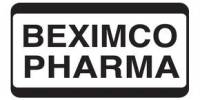Business plan For Neem Aerosol Spray
1.1 – Mission of Neem Aerosol Spray:
GREEN NATURE’s mission is to achieve business excellence through quality by understanding, accepting, meeting and exceeding customer expectations. GREEN NATURE follows International Standards on Quality Management System to ensure consistent quality of products and services to achieve customer satisfaction.
1.2 – Vision:
- Endeavor to attain a position of leadership in each category of its businesses.
- Attain a high level of productivity in all its operations through effective and efficient use of resources, adoption of appropriate technology and alignment with our core competencies.
- Develop its employees by encouraging empowerment and rewarding innovation.
- Promote an environment for learning and personal growth of its employees.
- Provide products and services of high and consistent quality, ensuring value for money to its customers.
- Encourage and assist in the qualitative improvement of the services of its suppliers and distributors.
- Establish harmonious relationship with the community and promote greater environmental responsibility within its sphere of influence.
2.0 – Industry Analysis:
GREEN NATURE produces neem soap, neem oil, neem uptan, neem shampoo, medicine from neem leaves etc. To give customers new experience of using aerosol, first time we are launching an aerosol which is made from neem and also health and environment friendly. We call it Neem Aerosol Spray.
2.1 – Competitors:
Our product is new in this industry therefore primarily we don’t have any competitor. But in the market there are lots of other aerosol sprays which are not health and environment friendly. So our aerosol spray is completely new and less harmful than others. So our chances of success are higher.
2.2 – Suppliers:
We need suppliers to help us to launch our new product Neem Aerosol Spray. They will take our product and distribute to the customer. Good suppliers are always needed to launch some new product and get connected with the customer.
2.3 – The Regulatory Environment:
Micro and Macro environment is going to affect the success of our new product called Neem Aerosol Spray.
Micro Environment:
The micro environment of the Company’s our customers, suppliers, competitors, Marketing intermediaries, employees, public, and partners which have great influence in success of the product. So, the company will has to maintain its CRM (Customer Relationship Management), PRM (Partner Relationship Management), ERM (Enterprise Resource Management), SCM (Supply Chain Management) and KM (Knowledge Management), so that we can ensure the quality and have a great image on the mind of the customers.
Macro Environment:
- Demography: The population of Dhaka and Chittagong city is increases, also the number of mosquito and other insects because of unhealthy environment around us. If we can provide better aerosol spray than others, then demand of our product will increase.
- Economic: If people’s income increases then everybody will have the ability to buy our product.
- Technological: Technological advancement is required for the increased sales.
- Political: If the government loses their rules and regulation such as imposing less income tax then our company can easily generate profit and can serve more customer
2.4 – Customer:
- Affordable price.
- High quality aerosol spray.
- Availability to the customers.
- Available throughout the country.
- Natural affect of neem.
2.5 – The Company’s place within the industry:
Company’s place:
- Legal Status: Public Limited Company
- Established: 2000
- Sector: Pharmaceutical, Consumer Products and Agriculture
- Company Location: Tejgaon I/A, Dhaka
- Country: Bangladesh
Industry’s place: Gajipur, R P Gate.
2.6 – SWOT Analysis:
Strengths:
- Strong distribution channel.
- Efficient and productive worker.
- Strong brand name in the aerosol industry.
- Totally nature & health friendly product.
- We focused on our natural resource.
Weakness:
- Limited financial resources.
- Less product Classification.
- New in the Market.
Opportunities:
- No Competitor in the market.
- We can export this product in future.
- Existing distribution channel will be used.
- High growth rate in this industry.
Threats:
- Competitor can produce the same product.
- Downward pressure on pricing.
- Political instability, economy etc.
2.7 – Porter’s 5 Forces Analysis:
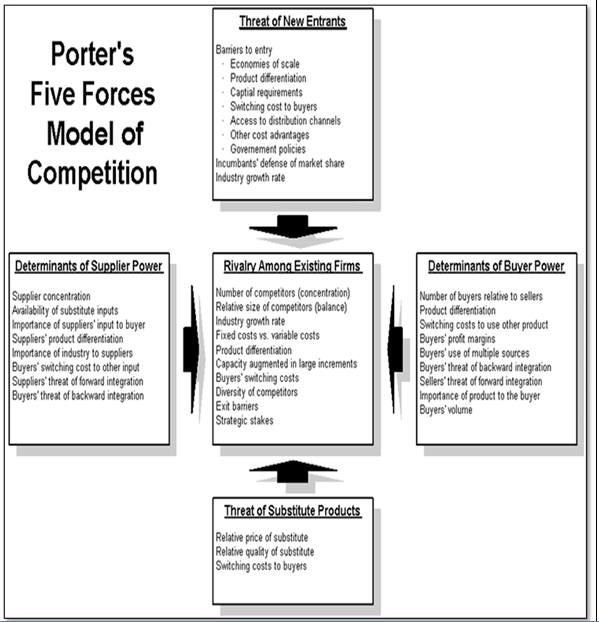
In current situation there are lots of competitors in the market. The price of our Neem Aerosol Spray of 250 ml is tk. 150. On the other hand competitors price are ACI Aerosol Spray 250 ml is tk. 200 & Mortein Aerosol Spray 250 ml is tk. 210. So we can say our product price is less than other two main competitors. And also we have 3 sizes spray so people can easily effort our product very easily.
In future, as our target group of customer is about the whole market, so we easily can expect that our product sell will be high. For having different size for different customer needs any level of people can buy this product easily because we have Family, Medium & Small size. As or market survey was successful so we can assume that our products future will be better than other products.
3.0 – Products and Corresponding Target Markets:
3.1 – Target Market Demographics:
Our target markets are separated into three segments. The segments are Middle class Family, Higher Middle class Family, Higher class Family and also for hospital, shop. The segment details are as follows-
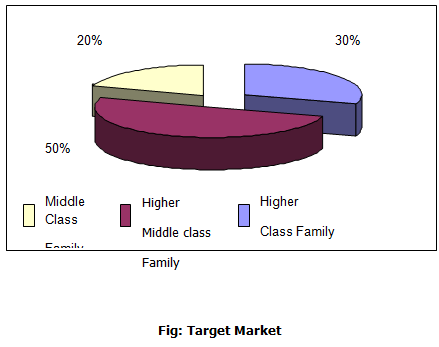
Middle Class Family:
Middle Class Family is vast population of our country and they don’t prefer aerosol spray that much. They used coil instead of aerosol. But we will try our level best to attract them with our Neem Aerosol Spray.
Higher Middle Class Family:
Higher Middle Class Family is health conscious and therefore they prefer the product that will keep away from diseases or any harmful hamper to their body. They are very much conscious about product quality and price and our product is quality maintained and affordable.
Higher Class Family:
In the Bangladesh there are many high class families who are try to use best product in market. If the price of that product higher than other they don’t hesitate to buy. Our Neem Aerosol Spray provides good quality, nice smell and finally no harmful hamper to health or nature.
3.2 – Industry or Social Trends:
We are going to introduce our new diversified aerosol spray product initially in 250 ml, 500 ml and 800 ml cans. It will be launched in steel cans. It will be launched in different prices like 150tk, 275tk & 385tk. According to the survey the target market growth rate is increasing. Thus we will attract our customers by our price and also quality.
3.3 – Our Target Customer’s Needs and Wants:
Above we describe about our target customers. They all need best quality within reasonable price. Here we are. We are providing best aerosol spray now in market. This aerosol spray made from neem tree. We reduce the harmful chemical in it’s and mixed neem with it. Thus our product becomes unique from other. We also reduce our prices of our aerosol spray. By doing all these we will be able to fulfill our customers needs and wants.
4.0 – Marketing Strategy:
4.1 – Positioning:
We are trying to position our product through image differentiation, because related marketing, and product differentiation. We will use logo and short advertisement so that people can consistently see the advertisement so the product will occupy a clear, distinctive, and desirable place in the mind of the consumer relative to competitors’ product. We will use USP (Unique Selling Proposition) for our product. To do brand differences that make a better differentiation or that has the potential to create company costs as well as customer benefits. A difference is worth establishing to the extent that it satisfies the following criteria-
- Important
- Distinctive
- Superior
- Communicable
- Affordable and Profitable
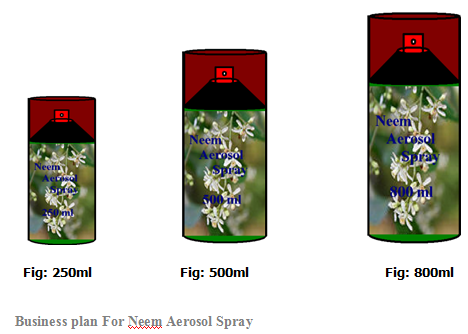
4.2 – Strategies:
The greatest objective is to establish our new brand in the industry. The marketing strategy will seek to first create customer awareness regarding the product and establishing connections with targeted markets and work toward building customer loyalty and referrals.
The major marketing strategies are-
- Increase awareness and Image: Informing the consumers about our new product Neem Aerosol Spray through, advertisement, leaflets, and billboard. We can increase awareness of the product and finally will be able to establish good brand image of our product.
- Cross Selling: We can use our existing distributors to distribute our new product. We will also be able to cross sell our new product with our existing products. This will help us promoting our new product to the market.
- Quality and test leadership: Our strategy is for being the quality and test leader in the market. We are going to offer two different type of aerosol spray.
- Mass distribution: We will also go for mass distribution of our product. We want to distribute our product each and every corner of the country.
4.3 – Marketing Mix:
Our marketing mixes for the new product Neem Aerosol Spray are
Product Marketing:
For launching a product in the market, there is some procedure that should be followed by every marketer to move in the long run. Our product will enable our customers to have a different experience to try our aerosol. They will be able to differentiate our product in quality which is unique in the aerosol spray market. They will not be able to feel the same way for the other aerosol spray in the market.
Pricing Strategies:
We shall charge based on “Overhead Expenses” and “Cost Plus”. Overhead Expenses include rent, gas and electricity, business telephone calls, packing and shipping supplies, delivery and freight charges, cleaning, insurance, office supplies, postage, payroll taxes, repairs, and maintenance. The accuracy of our costing will depend on estimating logical amounts for all categories of expenses. We have to list all overhead expense items and total they divide the total overhead figure by the number of items per month (or time period we used above).
The answer is our overhead per item:
Overhead + Materials + Labor = Total Cost/Item
From the market research, we received the following-
Product Name | Price |
ACI Aerosol Spray(250ml) | 200 |
Mortien Aerosol Spray (250ml) | 210 |
Neem Aerosol Spray(250 ml) | 150 |
We want to charge 250 ml Neem Aerosol Spray at the selling price of Tk.150. On the other hand, the prices for Neem Aerosol Spray are to be charged for 500 ml Tk.275, for 800 ml Tk. 375.
Place or Distribution:
We will primarily use our existing distributors for distributing our new product Neem Aerosol Spray then; we will make some new channels and assign some distributors to promote our new product to all over the country. So we are going to deal with this chain:

We are using mobile shop in the shopping malls, offices and crowded areas so that people can purchase the product easily when they like to consume. We will make our consumer by Value Delivery Network.
Advertising and Promotion:
The most successful advertising will be through BTV, NTV, Channel I, ATN Bangla, RTV, and CSB News which are the most popular television channels in the country. We will also use some bill-boards and leaflets and we will hold a sport event to promote the product. We will also use our experience so that we can create attention to the customers.
5.0 – Measurements:
A third party who facilitates a deal between two other parties Related Terms
- Middleman – Intermediary between a manufacturer and a consumer.
- Broker – An individual or firm who acts as an intermediary between a buyer and seller, usually charging a commission. For securities and… More
- Distributor – A company that buys open-end investment company shares directly from the fund for the purpose of reselling to interested buyers.
finder’s fee, investment bank, underwriter, counterparty risk, disintermediation, distribution network, market, rebate, acquirer
When finally our product will be made then at first we will survey this spray in our organization or people in our organization. If our employees says it is good or better than other spray and if they says”YES”it is harmless, effective and also environment friendly, then we will launch this product. To complete our survey we will collect the information about our Neem Aerosol Spray from our employee.
Selecting site:
Selecting a site
As suggested earlier, the process of site selection varies because each venture is unique. Suppose, for example, that an entrepreneur wants to open a drugstore. Before selecting a site, the entrepreneur first must ask questions such as those listed here, the to which come from marketing research:
On the City
Is the city growing? If so, how fast? What parts of the city are growing most?
What is the city’s population breakdown by age, income, and occupation?
How many drugstores are here now in the city? Where are they? How well are they doing?
What is the civic spirit like? Is the city progressive? Do residents work well together on civic project?
What is the quality of the city’s schools, churches, parks, and culture?
On an Area Within the City
What do Area consumers buy when they go to a drugstore?
What is the area’s population? Is it growing? Are the people chiefly native-born or foreign?
How do people make their living? Are they mostly white collar workers, labors, retired persons?
Are the people all ages or are the mainly old, middle aged, or young?
What is the average family income? What is their total buying power?
How many other drugstores are in the area? How success full are they?
On a Specific Site within the Are
Are neighboring business healthy?
How close is the nearest competing drugstore?
Is the site surrounded by well-kept homes?
Is there plenty of parking space available next to or near the site?
Is the site accessible by bus?
What zoning requirements must be met?
How far will customers have to travel to shop in drugstore?
Is there a steady flow of foot traffic by the site?
What is the floor area?
Is there any room to expand?
Can deliveries be made from the near?
Will near by stores draw customers to the site?
Is the appearance of the site pleasing? Will customer want to shop there>
Is there any divider on the road that may discourage some potential customers?
How we manage our Salespeople
We follow some policies to manage our sales people. These ways are described in below
Setting a sales target and then shoving it down their throats.
“People, especially salespeople, don’t like being dictated to,” says Mr. Nokib Khan Executive Manger of Neem Aerosol Bangladesh Ltd.He believes the old school of sales management tells people what to do. But the new school invites salespeople into the process of setting quotas and goals, allowing them to figure out what they are capable of achieving.
If you think this sounds like letting the inmates run the asylum, think again. According to one manager, the great paradox is that salespeople will invariably come up with a more aggressive sales goal when left to their own devices than if their manager sets the target.
“If you tell a salesperson he must do $2 million dollars next year, he will call you crazy and say it’s impossible,” says the sales manager. “But if you work with salespeople and encourage them to analyze their accounts, they’ll come up with a number that is consistently higher than what you would have set yourself. It’s really a shocking phenomenon.” So shocking that this manager often has to encourage his people to adjust their optimism and set slightly more realistic goals.
The secret sauce in the goal-setting formula is accountability. If salespeople feel like they helped shape the overall plan, they have a personal stake in the outcome. “By including your salespeople, you give them added motivation to succeed,” says Deceuster. “But without inclusion, salespeople will figure out the best excuses in the world why they can’t achieve.”
The Numbers Game
But what happens when upper management devises a wildly unrealistic sales target and drops it down from above? What should a sales manager do? Some managers who have been in this position say it is impossible to push back against management without losing their jobs. Likewise, it is imprudent to force the number on salespeople and expect them to perform.
“You work for the company, so it’s your obligation to reach the goal, no matter how unrealistic,” says one sales manager. “But it’s also your obligation to protect your salespeople from arbitrary numbers.” This manager suggests figuring out other ways to remunerate your salespeople other than simply quota-based commissions. That might mean convincing management to offer greater incentives or a higher base salary.
We needs to deliver against a number set by the corporate office. At Reed that number is not determined in a vacuum, but rather is based on direct input and data from people in the field. “Our sales targets start with the individual salespeople doing a strategic assessment of their accounts and territories, evaluating everything from revenue flow to run rates to new areas of growth,” Sales Manager explains. “We then take that data from the street and match it up with corporate objectives.”
Once the goals are set, Sales Manager , who manages a team that sells everything from traditional print ads for magazines to banner ads for online properties, meets with his people to review those goals on a weekly and monthly basis. “There has to be a continual dialogue,” says. “If we set a goal and don’t regularly assess what is happening, we’ll never reach the target.”
One Step at a Time
One another step that connects buyers and sellers of industrial products, says it’s crucial for salespeople to establish a set of daily, weekly and monthly benchmarks that help them measure and manage their ultimate goal. For instance, if one of her salespeople has a target of $1 million, she doesn’t ask them to focus on the actual dollars, but the activities that will help them reach that mark.
We believe it’s important to identify and measure several key success indicators, such as the number of follow-up appointments in a week, the number of networking events you’ve attended, or the number of contracts you’ve renewed. It even establishes weekly and monthly contests for her salespeople based on these very metrics. “By breaking goals down into smaller, easier-to-digest targets, you can start seeing the impact immediately,”. “It can be much more effective and rewarding, rather than simply striving for year-end results that are way down the road and seem so far out of reach.”
Another effective tactic for setting and managing sales goals is to step back and evaluate what went right and what went wrong the previous year. After all, if you don’t learn from our mistakes, we are doomed to repeat them. And if you don’t learn from your successes, you can’t replicate them.
“We have our teams write out three lessons from their successes and failures that can guide them as they move into the future,” says marketing manager. On the negative side, he finds that salespeople consistently believe they do not have enough time in the day to get things done, which prevents them from reaching their ultimate goal. The trick,, is getting them to reframe negative associations in a more positive light. For instance, you can’t change the number of hours in the day, but you can always find time to do what is important by prioritizing your tasks and systematically checking items off the list one at a time.
A Team Effort
Many sales managers employ a consultative approach when helping to set goals for their staff. Marketing Manger of Neem Aerosol first asks his team members to map out where they want to be financially and how much they want to earn. He then tells them to work backwards from there. “Let’s say a salesperson wants to earn $100,000 a year, and to get that, they need sales revenue of $1 million,” he says. “Together, we’ll look closely at each of their accounts and identify areas of growth where new sales can come from.” He wants his salespeople to be aggressive, but he is also careful that they don’t set themselves up for failure. For instance, a sales target of $5 million might be overly optimistic if the sales representative in question has never surpassed $1 million in his career.
Another effective tactic is encouraging sales staff to share their goals with the entire team and other people in the organization. When goals are shared, people become more vested in the outcome and ultimate success. “We break commitments to ourselves all the time, but once we inform friends, family and colleagues of our goals, the stakes are instantly raised,” says Lori Richardson, president of Score More Sales, a sales effectiveness organization. People are less likely to back away from their goals without giving it a lot of thought and reasoning first. What’s more, by trusting others with your goals, you acquire a support group that can help you stick with it and spur you on to success.
6.0 – Forecast and Financial analysis:
The new brands of “Neem Aerosol Spray” will be introduced in September. We make an action program for the next four months. And we believe that, if our four month action programs will run well, then we will achieve our goals easily.
June:
In June we will arrange meeting with our suppliers, dealers. And talk about our new product’s quality, product development etc. Our product is low involvement and buyers show habitual buying behavior. Then we will start production new Neem Aerosol Spray.
July:
After meeting with the dealers we will provide sample aerosol spray to our customers for getting publicity. On the other hand we will give advertise of our new product in the Television, Radio, Bill Board, Banners, and in the Poster. Then we will launch our product in to the market. In the primary stage we will produce 250ml and 500ml can.
August:
After doing our successful operations of two month, at the third month we give extra benefits to the dealers and sellers to improve our sales. We will give small toys; arrange game. Observing the situations, at this stage we will produce 250ml can, and 500ml can for the consumers. In this month we will start to produce 800ml can. And this month our product will be available in almost every shop of the country.
September:
In our last month of action program, if situation will favorable then we go for Divisional dealers to distribute to the whole country. Observing and analyzing we take necessary actions to develop product sales and increase our profit. In this way we will continue our production and give a particular image to the mind of every customer.
6.1 – Budget:
This section will offer a financial overview four company as it relates to our marketing activities. We have shown break-even information.
Break-even Analysis:
Cost | Taka |
Direct material | 20 |
| Direct labor | 10 |
Indirect material | 11 |
Indirect labor | 9 |
Fixed cost | 23 |
Manufacturing cost | 20 |
Sales & Promotion | 27 |
Total Cost | 120 |
At the very beginning, we want to go for Taka 60,000 Pcs production. And producing price is to be Tk 120 for 250 ml. This is our variable cost. Our selling price is = 150 taka. Our fixed cost is Taka 1,380,000. Contribution margin = 30 taka [150-120]
So our total cost is = {1,380,000+ (120*60,000)} Taka = 8580000Taka
Break Even Point:
Break-Even Quantity = (1380000/30) Pcs = 46000 Pcs
Break-Even Sales = (46000 * 150) Taka = 6900000 Taka
Here we do the break even analysis only for 1 product (250 ml)
6.2 – Sales Forecast:
The sales forecast is broken down into the three main revenue streams; direct sales, Web sales, consignment sales. The sale forecast for the upcoming year is based on 30% growth rate. Growth rate for year 2006 to 2010 are based on percentage increases as follows:
- Direct sales 20% growth rate per year
- Web sales 50% growth rate per year.
- Consignment sales 20% growth rate year.
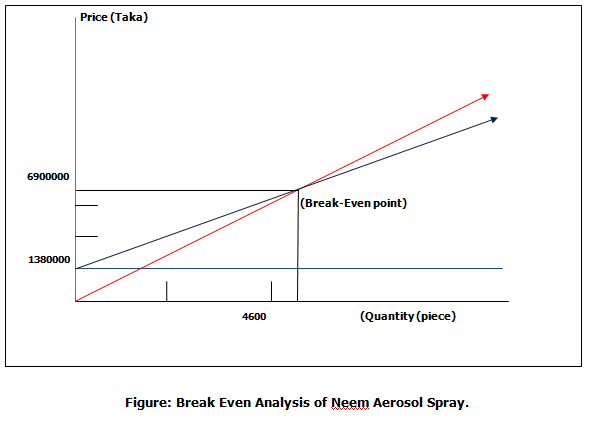
Conclusion:
We all know that, today’s fast moving world respect the new, innovative ideas. To keep the same pace with this situation our company had decided to launch a aerosol spray and it has a bright future in its market. As the product is innovative, the consumers are going to appreciate it. And according to the R&D (Research and Development) department this product will be a strong product mix for our company. And once our Neem Aerosol Spray will reach to the hand of our targeted customers, we will be able to capture the market.



